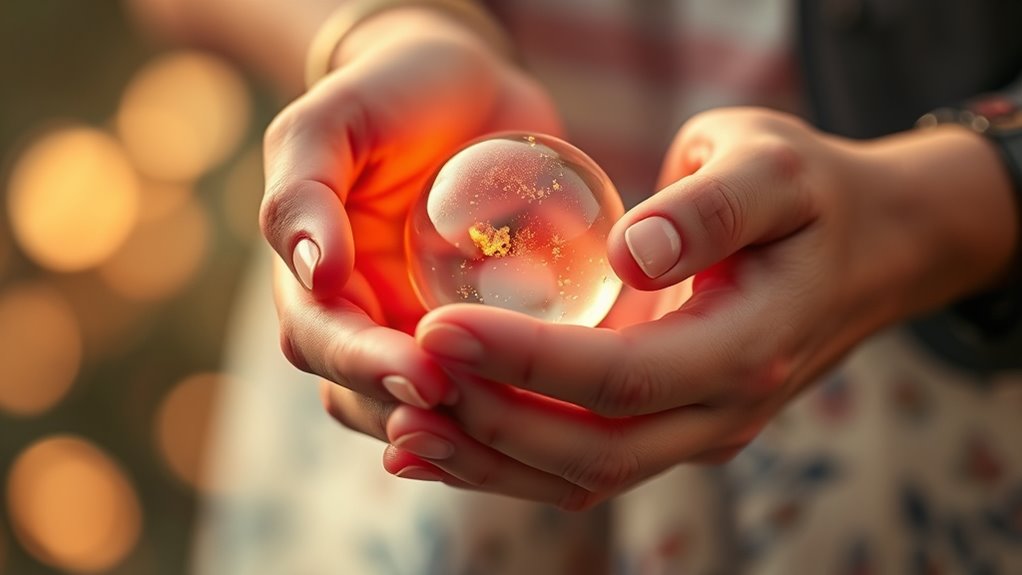When you experience love, your brain releases hormones like oxytocin and dopamine that shape how you feel and connect. Dopamine sparks feelings of pleasure, excitement, and motivation, activating reward centers in your brain. Oxytocin promotes closeness, trust, and intimacy, strengthening emotional bonds. These chemicals work together to rewiring your neural pathways, making love feel both emotional and chemical. If you keep exploring, you’ll discover how these hormones deeply influence your attachment and behavior.
Key Takeaways
- Dopamine activates reward centers like the nucleus accumbens, creating feelings of excitement and euphoria in love.
- Oxytocin promotes trust, safety, and emotional bonding by influencing social and attachment-related brain regions.
- Hormonal surges reinforce neural pathways associated with attachment, shaping perceptions and behaviors in love.
- Both hormones interact with specific brain areas, rewiring neural circuits to strengthen emotional bonds over time.
- The chemistry of love involves a complex interplay of hormones and brain activity that drives emotional and motivational experiences.

Have you ever wondered what truly happens in your brain when you fall in love? It’s a complex process driven by a fascinating interplay of hormones and brain activity. When your feelings start to grow, hormonal influences flood your system, triggering specific brain region activation that intensifies your emotional experience. These chemical messengers don’t just make you feel good—they actively shape how your brain perceives love and attachment.
Falling in love involves hormones and brain activity that shape your emotional and attachment experiences.
As you become infatuated, dopamine plays a starring role. Known as the pleasure chemical, dopamine surges in your brain’s reward pathways, particularly in areas like the nucleus accumbens. This increase makes you feel excited, euphoric, and motivated to seek out the person you’re falling for. It’s what’s behind that irresistible urge to see them, talk to them, and think about them constantly. Dopamine’s activation in these regions creates the addictive quality of love, reinforcing behaviors that keep you close to your partner. This is why being around someone you love feels so rewarding, and why the absence of that person can lead to feelings of longing or even withdrawal.
But dopamine isn’t working alone. Oxytocin, often called the “love hormone,” is equally vital. When you bond with someone—whether through physical touch, eye contact, or shared experiences—your brain releases oxytocin. This hormone influences brain region activation in areas associated with social bonding and trust, like the amygdala and the hypothalamus. It fosters feelings of closeness, safety, and attachment, helping your brain form a lasting connection. Oxytocin’s effects promote not just fleeting attraction, but genuine intimacy and emotional security. That’s why cuddling or holding hands can deepen your feelings and solidify your bond. Additionally, research shows that hormonal influences can alter neural pathways over time, strengthening emotional bonds and reinforcing attachment.
Hormonal influences like oxytocin and dopamine work together to create the multifaceted experience of love. They activate different brain regions, each contributing to the emotional, motivational, and attachment aspects of romantic relationships. Your brain essentially becomes rewired, prioritizing this person and reinforcing the desire to stay close. This neural activity explains why love can feel so powerful—your brain is wired to seek connection, driven by these chemical signals that shape your perceptions and behaviors. Understanding how hormones influence brain region activation gives you insight into the biological basis of love, revealing that what you feel is as much a chemical process as it is emotional and psychological.
Frequently Asked Questions
How Do Oxytocin and Dopamine Interact During Romantic Love?
When you experience romantic love, oxytocin and dopamine create a powerful neurochemical synergy that enhances your emotional bonding. Dopamine fuels your feelings of pleasure and reward, making you crave your partner’s presence, while oxytocin deepens trust and attachment. Together, they reinforce the emotional connection, making love feel both exhilarating and comforting. This dynamic interplay keeps you emotionally engaged and strengthens your bond over time.
Can Love Chemicals Influence Long-Term Relationship Stability?
Love chemicals are like the tender threads weaving your relationship’s fabric. They influence your neurochemical balance, shaping emotional resilience over time. When these chemicals are in harmony, they bolster trust, intimacy, and stability, helping your bond withstand life’s storms. However, if imbalanced, they can weaken your connection. So, nurturing these neurochemicals through shared experiences and open communication can help sustain long-term love, turning fleeting sparks into enduring flames.
Are There Ways to Naturally Boost Oxytocin and Dopamine Levels?
You can naturally boost oxytocin and dopamine levels through lifestyle changes and natural supplements. Activities like hugging, kissing, or spending quality time with loved ones increase oxytocin. Regular exercise and listening to music can elevate dopamine. Incorporate natural supplements like magnesium or omega-3s into your routine, and prioritize stress reduction and healthy habits. These approaches help enhance your mood and strengthen your emotional bonds naturally.
Do These Chemicals Affect Attraction Differently in Men and Women?
Gender differences and hormonal effects influence how oxytocin and dopamine impact attraction. You might notice that men and women experience these chemicals differently due to varying hormonal responses, affecting how they feel drawn to someone. For example, oxytocin may boost bonding more strongly in women, while dopamine’s role in reward could be more pronounced in men. These hormonal effects shape attraction and attachment uniquely across genders.
How Do Love Hormones Impact Mental Health and Well-Being?
Imagine love hormones as the orchestra conducting your mental symphony. When balanced, they boost your neurotransmitter harmony, strengthening your emotional resilience and brightening your outlook. These chemicals can lift your mood, reduce stress, and foster a sense of connection, creating a more stable mental state. However, imbalance may lead to emotional turbulence, highlighting how love hormones play an essential role in your overall mental health and well-being.
Conclusion
As you realize how oxytocin and dopamine shape your feelings, think of love as a powerful chemical symphony inside your brain. Just like a dance that sparks joy and connection, these chemicals orchestrate your emotions, making you feel alive and bonded. Imagine a couple’s first touch—your brain floods with these love molecules, turning simple moments into unforgettable melodies. Understanding this science helps you see love not just as magic, but as a beautiful, intricate dance of chemistry.










